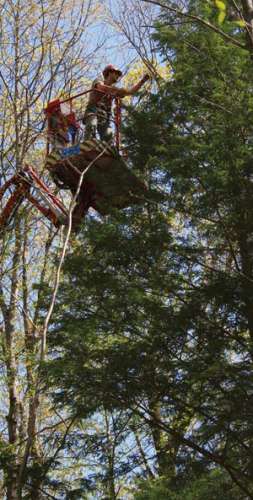When the hemlock wooly adelgid, an invasive pest that sucks the life out of eastern hemlock trees, made its appearance in New England forests in the 1970s and 80s, many forestry experts expected it to wipe out all hemlocks in the region by about the turn of the century. When another damaging hemlock pest, the elongate hemlock scale, arrived soon after, some speculated that the trees might disappear even sooner. Yet, oddly enough, hemlocks are doing better in areas where both pests are present than they are in areas with just the adelgid.
University of Rhode Island ecologist Evan Preisser, who has been studying the pests for more than a decade, says that despite what logic would suggest, in this case two pests are not worse than one. “How do you reconcile that the scale appears to be in higher densities in an adelgid dominated landscape?” he asked. “If you have two herbivores eating something, one’s food should be the other’s loss of food. But that doesn’t seem to be the case.”
Adelgids are known to kill hemlocks within a few short years; the scale just causes a chronic unhealthy state. To test what happens when both pests are present, Preisser introduced the insects to individual branches in a hemlock forest. “What we found was that the scale by itself hurt the branch a little, the adelgid and scale together hurt it a little more, and the adelgid by itself was the worst,” he said. When both pests were introduced to the same branch, the abundance of each declined by about 30 percent.
Preisser said that in its native range in Asia, the adelgid creates a gall on spruces, which causes changes in how the trees allocate nutrients. “The adelgid induces a strong hypersensitive response in the tree, which causes lots of cell death, even in areas that don’t have adelgids, whereas scale causes cell death right where it feeds, but no downstream death.” He believes that the adelgid manipulates plant chemistry to bring food to itself at the expense of the tree, but when the scale is also present, the scale consumes much of that food.
It may appear that the scale could be used to reduce the harmful effect of adelgid-infested hemlock forests, but Preisser does not believe that is a good idea. The adelgid feeds exclusively on eastern hemlocks in North America, but the scale feeds on other conifers and is especially damaging to Christmas tree groves, so intentionally releasing the scale would likely cause widespread harm to other trees.
Preisser is continuing his studies of the pests to try to learn how the adelgid manipulates hemlock chemistry and what the scale does to counteract this manipulation. He hopes the scale can continue to buffer the effect of the adelgid long enough for what he calls “a promising biological control” for the adelgid to be approved for use.


